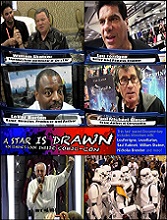National Geographic – A crane hoists A-12 debris (right) onto a flatbed truck at the site of the 1963 A-12 crash in Utah. Part of an engine nacelle and an exhaust ejector are visible at left.
Though the CIA has released some photos of the incident, officials remain mum about exactly who was involved in the cover-up and how it was carried out. “There’s nothing I can tell you about how [this or] any other incidents were or are handled,” CIA historian David Robarge said.
Aerospace historian Peter Merlin, who has examined this crash site and several others involving secret aircraft, said he’s pieced together at least part of the cover-up story.
“The A-12’s fuselage and wings were cut apart with blowtorches and loaded onto trucks along with the tails and other large pieces,” he said. “Smaller debris was packed in boxes.”
In an undated picture, a mock-up of the A-12 spy plane sits perched upside down on a testing pylon at Area 51—part of radar tests to reveal how visible, or invisible, the design was to radar.
Area 51 staff had to regularly interrupt such tests and hurry prototypes into “hoot-and-scoot sheds”—lest they be detected by Soviet spy satellites.
The Soviets unwittingly provided raw materials for the unprecedented plane. The A-12 was about 93 percent titanium, a material then unheard of for aircraft design. Most of the men who built the craft are still wondering today how that metal was secretly sourced from inside the U.S.S.R., according to the new documentary.

Before the cleanup, after pilots from Area 51 had reported that the wreck in Utah was still identifiable, crews quickly covered all large pieces with tarps.
“At the time of the crash, the OXCART program was a very closely kept secret, and any exposure of it—such as through a crash that got publicized—could have jeopardized its existence,” the CIA’s Robarge said.
“If U.S. adversaries used that disclosure to figure out what the program was about, they might have been able to develop countermeasures that would make the aircraft vulnerable.
“The U.S. government had to make sure that no traces of the 1963 crash might be found and give hostile powers insights into the engineering and aeronautical advances the program was making.”



